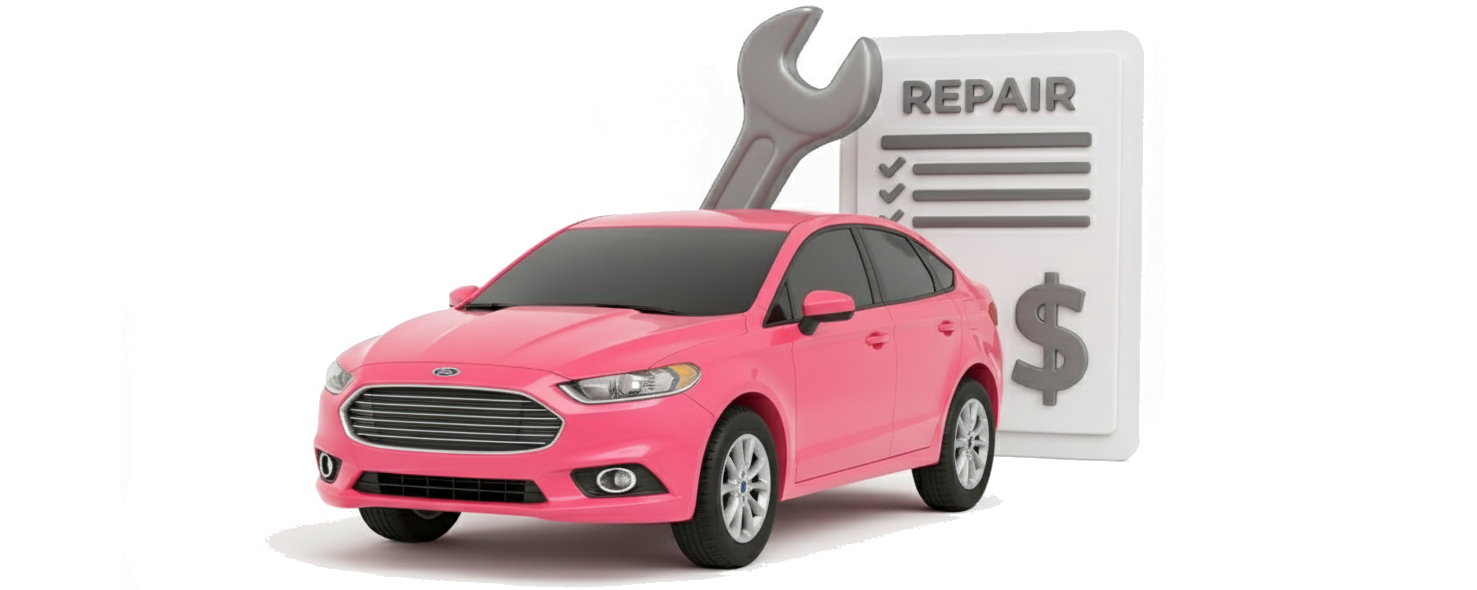The exact price depends on your exact car, location, and the repair needed. The Jerry app helps customers get precise quotes for their car and city.
Cost breakdown: Why the price varies
Driving your total is what failed, access difficulty, parts quality and labor rate. Jerry helps customers find dependable prices each day and has found the following reasons prices can vary:
Part type:
Blades are cheap consumables while motors/linkages/switches are pricier (parts often make up 40%–70% of the total for these jobs).
Labor time:
Blade swaps take minutes, linkage/motor access often runs 1–2.5 hours. Some Euro cars add 0.5–1.0 hour for hard-to-reach parts near the windshield.
Vehicle design:
More complicated repairs like taking off a plastic cover at the base of the windshield and putting the wiper arms back in the right position add time. Use “service position” on many VW/Audi/BMW to avoid cowl/hood scuffs.
Parts quality:
Premium beam blades cost $25–$40 each; basic refills can be under $10. OEM motors/linkages are often 20%–50% more than aftermarket.
Front vs. rear:
Rear motors/blades are smaller/cheaper, so rear wiper repair cost is usually lower, but interior trim removal adds time.
Rain-sensing systems:
Blades are standard, but sensor/glass work may require calibration (0.3–1.0 hour; some cars need a scan tool).
Corrosion/climate:
Stuck joints or rusted arm splines (gear-like ridges that the wiper arm grabs) increase labor; Snow Belt cars see more bushing/arm replacements.
Real customers Jerry helped
The price range for a windshield wiper repair can vary based on your specific car, location, and parts used. But Jerry makes it easy to see what others are paying right now. Here are some examples of customers we’ve helped find the very best prices for their windshield wiper repairs.
Estimates are modeled based on real vehicle and location data; names have been changed. Actual prices will vary by shop, parts, and vehicle condition.
What is a windshield wiper system?
A windshield wiper system includes the wiper blades you see on the glass, the arms that move them, and an electric motor and linkage that sweep the blades back and forth. The system also has a washer pump, fluid reservoir, and spray nozzles to lift off dirt and bug residue. Most cars let you choose multiple speeds and an intermittent setting (setting that makes the wipers pause between swipes); many newer models add rain-sensing wipers that adjust automatically when the weather changes.

What are signs that I need wipers repaired?
Customers use the Jerry app to give them confidence in their windshield diagnosis before taking their car to the shop. Watch for early clues and match them to likely causes.
- Streaks, smears or chatter: Worn/dirty blades or contaminated glass. Clean and replace as needed.
- Skipping or thumping: Hardened rubber or poor contact—beam/winter blades or fresh rubber will fix it.
- One wiper not moving: Loose arm, stripped splines or a popped linkage bushing. If it moves easily by hand, address the arm/linkage.
- Both wipers slow or stop mid-sweep: Weak motor, stuck joints, a bad electrical connection to the car’s body, or a weak battery.
- No function at all: Check fuse first, then relay/switch. Motors do fail, so verify power/ground at the motor before replacing.
- Washer doesn’t spray: Empty tank, clogged nozzles, kinked hose or a dead pump. Listen for pump hum when pressing the stalk.
- Won’t go intermittent or won’t park: Switch/park circuit or motor contacts.
- Rain-sensing erratic: Dirty sensor area or displaced gel pad after glass work; some vehicles require scan-tool calibration.
Pro tip: Seized pivots can mimic a “weak motor.” Free or replace pivots before condemning the motor.
Your action plan: How to save money
Here’s what to consider when getting your windshield wipers repaired to help you save money and gain piece of mind:
Start by noting the symptoms: Streaks, chatter, skipping, weak spray, or dead speeds—and when they occur (first swipe, highway speeds, or heavy rain). The Jerry app can help customers get a reliable diagnosis
Do a quick at-home check:
Top up real washer fluid, inspect the rubber for tears, clear any ice, and try every wiper speed and the washer.
Decide what’s DIY and what’s not:
Blades and fluid are easy to handle yourself, while the motor, linkage, wiring, pump, or rain sensor are best left to a mechanic.
Bring helpful info to the shop:
Short photos or video of the issue, your VIN, blade sizes from the manual, and any dashboard messages.
Ask clear questions:
What failed and why, whether parts are OEM or aftermarket, what the parts and labor warranties are, the out-the-door price, and the ETA.
Get multiple quotes:
Compare quotes from 2-3 shops to make sure you’re getting the best price. Each day, customers use Jerry to help them get accurate repairs from multiple repair shops
Pro tip: Many wiper systems use $5–$15 plastic clip kits (tiny connectors called bushings)—no need to replace the whole mechanism if the arms still move freely.
Whatever the root cause is, the Jerry app can help you compare pricing to find the right local shop for your needs.
DIY vs. Pro: Can I do this myself?
Many drivers can handle blades and basics; motors/linkages/switches are for pros unless you’re comfortable with wiring and trim. Whether you want to do it yourself or leave it to a pro, the Jerry app can give you transparency around parts and labor prices to go into the repair with confidence.
Related repairs
Small add-ons can restore visibility and prevent repeat visits. Jerry customers can use the app to get accurate quotes for multiple services at once.
- Windshield glass care: Clean off stuck grime with rubbing alcohol. Avoid wax/silicone on the wipe path.
- Washer system service: Pump, cleared nozzles or fresh hoses; use winter-grade, de-icer fluid in cold climates.
- Switch/relay replacement: If intermittent or park is flaky.
- Rain sensor service: Clean/re-center and replace gel pad after glass work.
- Battery/charging check: Low voltage causes slow/erratic wipers.
- Cabin air filter: A clogged filter fogs windows faster.
- TSBs/recalls: Some models have motor/module/linkage updates.
- Water intrusion: Water can leak under that plastic cover and rust the plugs and wires.
Pro tip: Buy smart, as mid-grade beam or winter blades outperform more budget purchase options and last longer.
FAq
-
How often should I replace wiper blades?
-
Can I replace just one wiper?
-
My new wipers still streak—why?
-
Are premium blades worth it?
-
What if my wipers were frozen to the glass?
-
Do rain-sensing wipers change costs?
-
Will insurance cover wiper repairs?
-
What size wiper blades do I need?
-
My washer works but wipers don’t—what’s up?

Beginning with Hot Wheels toys as a preschooler, Rocco’s lifelong passion for cars has taken him from high school occupational courses to decades of master mechanic experience in mobile, dealership and independent auto shops.
Rocco’s professional career began in 1997 with factory Ford training in San Diego. While gaining invaluable experience in dealerships and independent shops, he went forward to complete Toyota factory training and graduated from the Universal Technical Institute near Chicago in 2009.
In 2014, Rocco opened Rocco’s Mobile Auto Repair in California servicing Los Angeles, Orange and San Diego Counties with both individual and fleet-based services. After years of success, Rocco shifted his work model from running a business to managing an independent automotive shop. Now in Tennessee, he focuses on training new technicians to be their best.

Steve Kaleff began working on cars at the very young age of nine years old, when his dad actually let him make fixes on the family car. Fast forward to the beginning of a professional career working at independent repair shops and then transitioning to new car dealerships. His experience was with Mercedes-Benz, where Steve was a technician for ten years, four of those years solving problems that no one could or wanted to fix. He moved up to shop foreman and then service manager for 15 years. There have been tremendous changes in automotive technology since Steve started his professional career, so here’s looking forward to an electric future!

Nick Wilson is an editor, writer, and instructor across various subjects. His past experience includes writing and editorial projects in technical, popular, and academic settings, and he has taught humanities courses to countless students in the college classroom. In his free time, he pursues academic research, works on his own writing projects, and enjoys the ordered chaos of life with his wife and kids.










